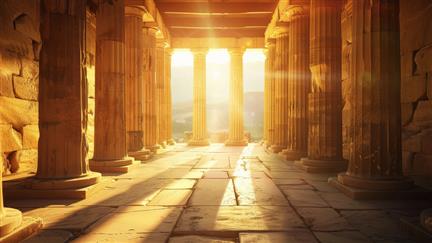
Jerusalem Temples
Corroboratory evidence exists relating to the structure of the first Temple by the discovery of Copper Mines in the southern Negev region, which was part of Edom. Excavations show that copper production in this region peaked during the 10th century B.C. at the same time of the reign of King David and King Solomon. Also found in this area were 10th century B.C. weaponry, a 5-meter-high fortified wall, a gatehouse and a donkey stable with ancient manure showing that the straw that the donkeys ate came from Jerusalem.
Another piece of evidence that corroborates the Biblical narrative that Solomon had aid from the Phoenician King Hiram in the building of the first temple was the discovery of a royal sarcophagus dated from the 10th century B.C. It was discovered in Byblos and the inscription on it reads, “Ahiram, King of Byblos”. Also, Jeroboam’s altar may have been discovered at the Tel Dan excavation site. He set up this pagan altar so that his people would be able to worship close by instead of having to travel to Solomon’s temple in Jerusalem to worship God.
A huge, raised platform was discovered in Tel Dan with a 10-foot-high altar, 2 staircases and sacrificial items nearby. These items were dated to the 10th to 8th centuries B.C. which is the when the northern kingdom of Israel existed. Another significant discovery attesting to scriptures requiring altars to have a “horn” on each corner is the “four-horned-altar” found in Beersheba and dated to the 8th century B.C. Another piece of corroborating evidence for the existence of the first temple is the amount of gold paid to the Assyrian King Sennacherib by Hezekiah. The amount of gold paid to him is documented on Sennacherib’s Prisms. “As for Hezekiah, the terrifying splendor of my majesty overcame him … In addition to the thirty talents of gold … [continues to list a variety of other items, including silver] which he had brought after me to Nineveh, my royal city. To pay tribute and to accept servitude, he dispatched his messengers.” This gold most likely came from Solomon’s temple. Another fascinating discovery related to the first temple is an ostracon found at Tel Arah dating to the early 6th century B.C. It mentions the “house of YHWH” which was the name of the Jerusalem temple.
An artifact was found relating to Zerubbabel’s construction of the second temple called the Cyrus Cylinder. It contains text stating that a decree went out to the Jews in Babylon that they would be allowed to rebuild their temple in Jerusalem. Two large stone temple Warning Inscriptions were found in Jerusalem in the late 1800s warning non-Jews of the death penalty if they were caught going into the Israelite area of the temple. “NO FOREIGNER IS TO GO BEYOND THE BALUSTRADE AND THE PLAZA OF THE TEMPLE ZONE. WHOEVER IS CAUGHT DOING SO WILL HAVE HIMSELF TO BLAME FOR HIS DEATH WHICH WILL FOLLOW.”
Other evidence of the existence of the 2nd temple comes from the eyewitness accounts of first century historians Josephus and Philo. Josephus wrote the temple being surrounded by a stone wall and described the inscription on it. He and Philo also mentioned the warning inscription about foreigners crossing the boundary line. The entire layout and measurements of the temple were written about in the Mishnah. Evidence for donations given to Herod for the building of pavement in the temple was found in an inscription on a large stone at the southwest corner of the Temple Mount called the “Trumpeting Place Inscription”. A limestone vessel was also discovered in the same area with a depiction of 2 upside-down birds and the word “Korban” which represents a sacrifice. Ritual purification baths called “Mikvaots” were discovered within ancient Jerusalem indicating that people needed to cleanse themselves before entering the temple.
The Arch of Titus erected by Emperor Domitian was found in Rome dating to the first century. It displays a procession of people carrying away treasures from the destroyed Jerusalem temple. The Bar Kochba coins were minted by the Jews during the Bar Kocha Revolt (132-136 A.D.). One of the coins depicts the four-pillared Herodian entrance of the temple with a representation of the Ark of the Covenant in the center.
-
bhodges193
8/9/2024
Nice article!